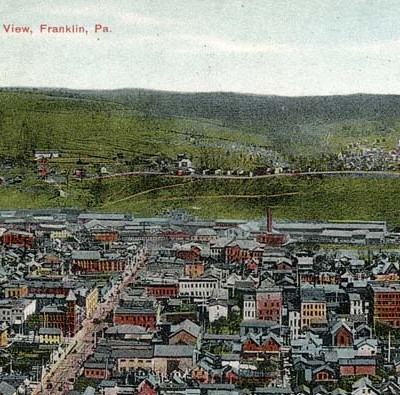
Franklin, Pa. was settled in the 1740s and named after Benjamin Franklin. The town was incorporated as a borough in 1828 and was incorporated as a city in 1868, after oil discoveries in Venango County and neighboring Crawford County brought thousands to the area.
The first Jewish settlers arrived before the oil boom. Abraham Burgauer immigrated to Franklin from Bavaria in 1838 and ran a grocery store in the borough until 1868, when he moved to Allegheny City, according to his obituary. Moses Koch came to Franklin about 1839 and left for Erie in 1842. His father-in-law Simon Ulman was living in Franklin as late as 1843 but had moved to Philadelphia by 1850. After immigrating to New York from their native Bavaria, Charles and Rose Reizenstein briefly sold lamps in Franklin before moving to Allegheny City in about 1866.
With the discovery of oil, the population of Franklin increased dramatically and the Jewish community became more organized. A group of mostly German immigrants chartered Congregation Emanuel in 1865 or 1866, which would make it the first Jewish congregation to be chartered in Western Pennsylvania outside of Pittsburgh. Congregation Emanuel dedicated a synagogue on Doe Street (now 13th Street) during the High Holidays in 1865, according to an article in the Venango Spectator. Judge Josiah Cohen of Rodef Shalom Congregation in Pittsburgh delivered a keynote address at the dedication. The Jewish community of Franklin established B’nai B’rith Lodge No. 80 in 1866 and the short-lived Kesher Shel Barzel Lodge Union 45 during the 1870s. Around this time, the community also started the Mt. Zion Jewish Cemetery in Sugarcreek Township. The earliest dates found in the cemetery are a pair of burials from early 1871. The Jewish population of Franklin peaked in 1873 at 175 people and 35 families, according to historian Jacob Feldman, who cited a notice in the American Israelite.
The need to transport oil from fields in northwestern Pennsylvania to refineries in Pittsburgh created heavy river traffic in the region and allowed many Franklin businessmen to regularly move between the oil region and the urban center to the south. The first two presidents of Congregation Emanuel, Charles Zeugsmith and Abraham Klinordlinger, both moved to Pittsburgh about 1870 and became members of Rodef Shalom Congregation in the city.
As oil fields in northwest Pennsylvania were depleted in the 1880s, the economy of the region stalled and many Jewish merchants left the area. The Jewish population of Franklin fell to 131 by 1880, according to the volume Statistics of the Jews of the United States. The B’nai B’rith lodge in Franklin merged with a lodge in nearby Corry about 1899. Congregation Emanuel appears to have been dormant through the beginning of the 20th century. In 1915, a new group of residents voted to revive Congregation Emanuel “after a lapse of nearly forty years” and hired a rabbi, according to an April 21, 1915 article in the Venango Citizen-Press. At the time, the congregation counted 14 members, only two of which had belonged to the earlier congregation. The American Jewish Yearbook listed a Jewish population of 34 in its 1928-1929 edition and a population of 68 in its 1940-1941 edition. By about 1940, though, Congregation Emanuel had dissolved for a second time and some of its members had joined Tree of Life Congregation in nearby Oil City.